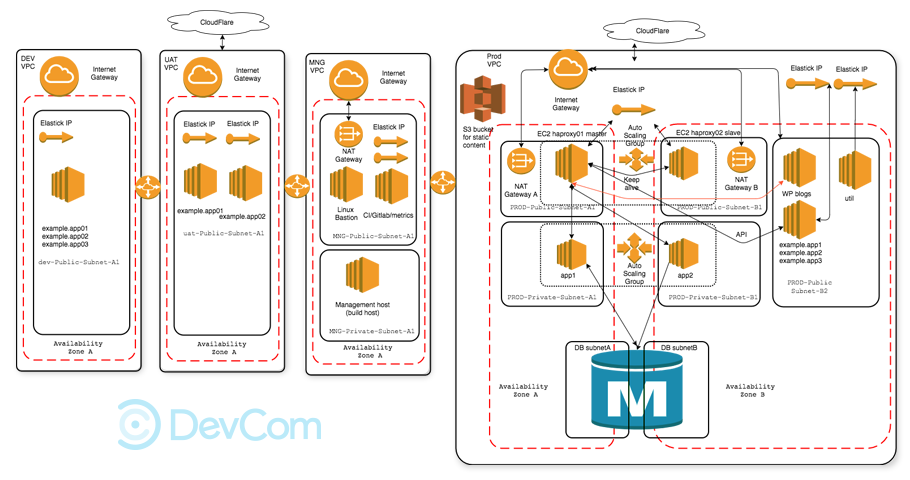
IBM SoftLayer to AWS Migration for the US Online Retailer
Software supplier

Product
Website design
The project involved migrating an online retailer's infrastructure from IBM SoftLayer to Amazon Web Services (AWS) to address low performance and high hosting costs. With over 10,000 products and a high volume of daily orders, scalability, reliability, and cost-effectiveness were critical for the client's eCommerce business. The migration decision was driven by the need for better performance, scalability, support, and flexibility without inflating costs.
The migration to AWS and adoption of Cloud Flare provided enhanced security and scalability. Leveraging AWS services such as Amazon EC2, Amazon S3, Amazon RDS MariaDB, and AWS Database Migration Service (DMS) facilitated seamless transition and ongoing replication without downtime. The migration resulted in significant cost savings, with a reduction of 44% annually in hosting costs while improving performance and stability.
The benefits of the migration included improved scalability, performance, security, and user experience. AWS offered better pricing, scalability, and security than IBM SoftLayer, making it an ideal choice for the client's business needs. The successful migration demonstrated the advantages of utilizing AWS for eCommerce businesses, showcasing improved performance, stability, scalability, and cost savings.
For organizations considering a migration from IBM to AWS, trusted DevOps architects and advisors provide analysis and recommendations tailored to specific usage patterns and infrastructure requirements. Cloud migration offers opportunities for cost savings, scalability, and agile deployments, making it a compelling option for organizations seeking to optimize their hosting solutions.
Technology Stack
- Cloud Flare
- AWS DMS
- RDS
- S3
- EC2
- CloudFront
- Ri’s vs Saving Plans
- CI/CD (Jenkins)
- Apache
- HAproxy
The problem: Low performance and height hosting cost
The client rented physical servers from IBM SoftLayer. He was worried about the state of those physical servers and the risk of possible breakage. It could cause a pretty long downtime for the system – to restore the system and replace the broken data or web server. Keeping a similar server in an on-hold mode was quite expensive approach. Also, the client couldn’t build capacity as and when needed. This caused performance, flexibility, and scalability issues.
The underlying technology for a client’s eCommerce business is mission-critical in engaging and selling to customers. The website traffic could fluctuate from quiet times to campaign-driven traffic spikes. Scalability is critical for a company that experiences sales surges. The easier it is to scale, the easier it is to focus on its core work: delivering products to customers across the USA (and sometimes Canada and the EU).
So, when the client began experiencing capacity issues, there was a choice: either invest in bigger boxes and more RAM or move to the cloud. Continuing to use a hoster meant spending between 25% to 50% more than was needed.
We wanted better performance, scalability, support, and flexibility in a solution that didn’t break the bank.
The solution: Migration to amazon web services (AWS)
After evaluating several solutions, it was decided to eschew the IBM Softlayer provider in favor of Amazon Web Services (AWS) and Cloud Flare based on its strong network proposition.
Security and scalability—those two things were critical for us. By using CloudFlare, we got the protection we needed. It was easy to implement and very cost-efficient.
Ultimately, AWS represents one of the most advanced, reliable cloud-based environments. It is cost-effective, and AWS has a far more extensive developer toolset available than IBM Softlayer.
The client’s business is running its website using core AWS services.
Amazon Elastic Compute Cloud (Amazon EC2) provides resizable virtual computing resources. Multiple Availability Zones help to ensure that buyers have a reliable, always-on service site. Files are stored in the Amazon Simple Storage Service (Amazon S3). The client uses the Amazon Relational Database Service (Amazon RDS MariaDB) to deliver a highly scalable primary database for staging and production systems. The AWS Database Migration Service (Amazon DMS) was used to migrate the database from a source on-premises Mysql Server to an RDS MariaDB with ongoing replication without downtime.
Supporting major technologies, AWS brought the following benefits:
- Cost. When comparing the pricing, AWS gave better results for much lower pricing.
- Scalability. We created a system that is scalable and reliable.
- Security. eCommerce businesses can grow securely and be supported through AWS. The AWS Cloud has numerous 3rd parties certifications, so we felt safe knowing the data can be secure.
- UX. Compared to IBM, AWS is more mature in enterprise integration, developer services, scaling, technical support, and ease of deployment.
Result
The advantages of migrating to the AWS cloud are apparent; the facts and numbers show it:
- Moving to the AWS environment, the DevOps team had left almost the same configurations while significantly improving scalability and performance.
- Saves 44% annually on hosting costs. Previously, the client spent tens of thousands of US dollars per year hosting in IBM SoftLayer cloud infrastructure. After migration to AWS, the price was cut on 44% per year with better performance, stability, and scalability. That gave a number of $$,$$$ (5 digits) of savings per year.
Is a migration from IBM to AWS right for your organization?
Deciding to utilize public cloud services for cost savings, scalability, and agile deployments is a foregone conclusion for most organizations.
Cloud migration is a procedure we’ve performed many times for a wide range of organizations, so please reach out to us if you want to learn more about IBM SoftLayer to AWS migration.
Trusted DevOps architects and advisors provide analysis and recommendations for your website hosting. Based on your usage patterns, configurations, and other infrastructure information, you will get a clear picture of actions you should take to increase security and decrease costs.

worked on this project
Ihor
Account Manager (AM)



